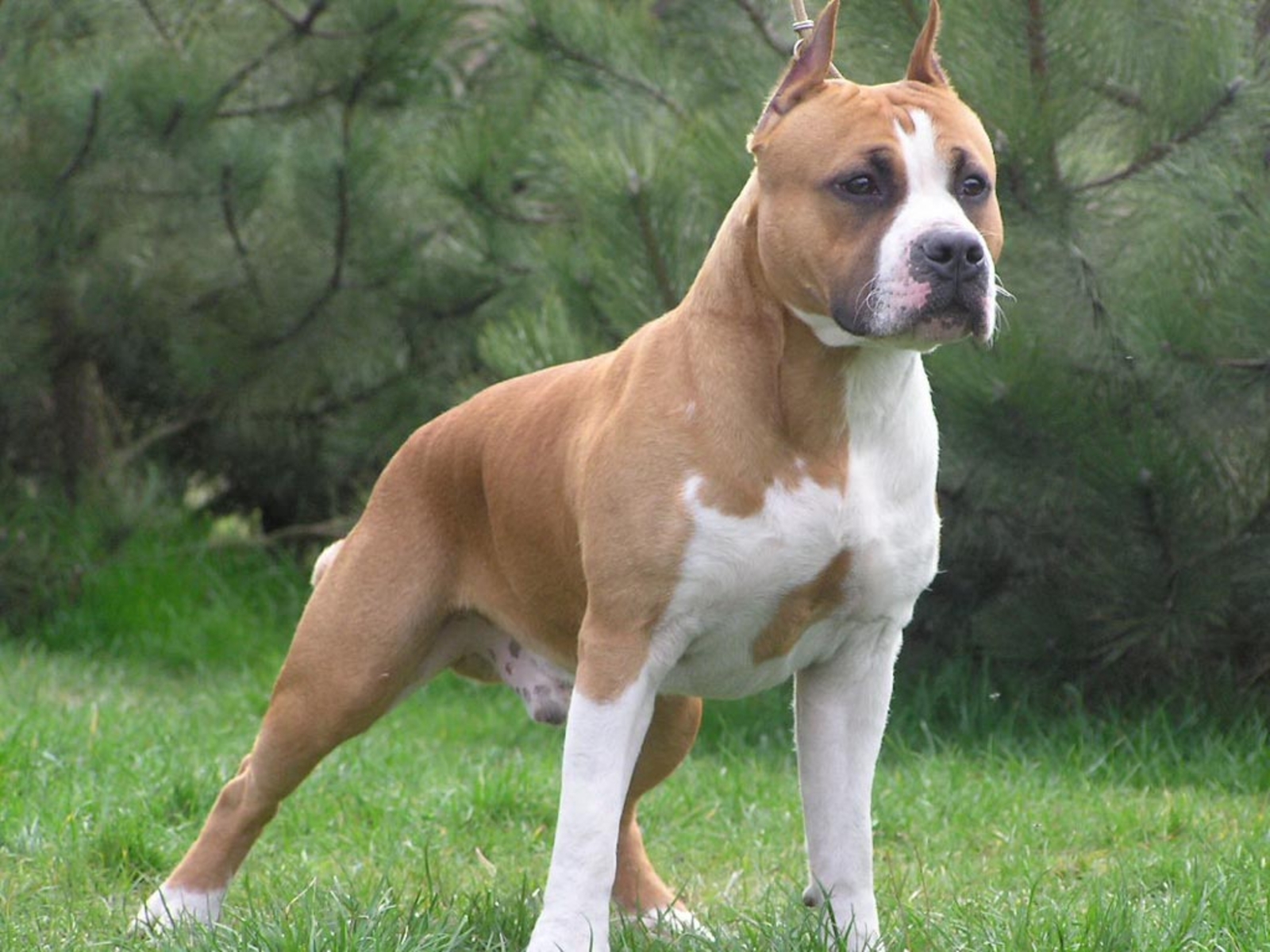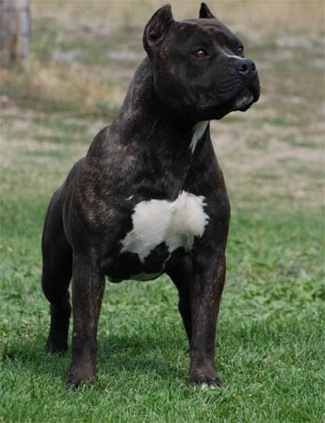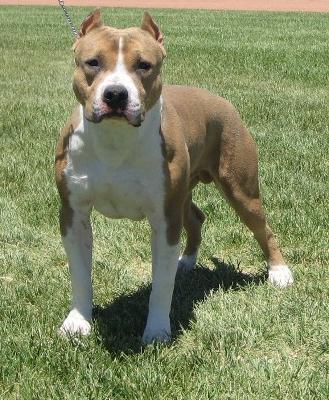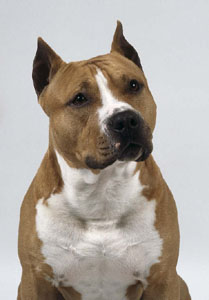
The Breed History
The powerful Greek Mollossian dogs gave rise to the Mastiff strain
of dogs. Early Mastiff lines were used to produce fighting dogs. The
very early original English Bulldog-type was similar to the modern
American Staffordshire Terrier and the Staffordshire Bull Terrier,
though the Staffordshire muzzles are longer. It is thought that the
English Staffordshire Bull Terrier resulted from a bulldog crossed with
Fox Terrier, extinct English White Terrier and/or Manchester terrier.
First AKC registry occurred in 1936, but the American breed had
changed in stature (heavier and taller than English version) and
those larger dogs were now called American Staffordshire Terrier
instead of Staffordshire Bull Terrier. The increased size may have
resulted from outcrosses in those lines. There is considerable
confusion regarding the American Pit Bull Terrier (American Pit Bull,
Pit Bull Terrier) and this breed, the American Staffordshire Terrier.
Some registries separate them (such as the UKC); others such as
the AKC do not. In stature, the Pit Bull is generally heavier (10-30
lb) and taller (2") than the American Staffordshire Terrier, though
since overall body type and temperament are very close, they can be
considered a size variant. Those that separate out the Pit Bull point
out that additional fighting bulldog outcrosses may have occurred
in those lines, and the Pit Bull is not the older, original breed
developed for bull baiting as was the Staffordshire, but a fighter
dog of more recent origin developed in the US. Facial features vary
slightly between Pit Bull and Staffordshire.
Breeding for Function
Hallmark characteristics for the breed fully reflect his original
function as a fighting dog and bull baiter, and include exceptional
courage, aggressiveness, lightning quickness and agility, remarkable
strength, a very strong tenacious bite and powerful head and jaws
with a muscular neck to back it up. In America, the breed was
helpful around the farm as hunter and guard dog. In recent years,
increased companionability has been stressed in breeding programs.
Physical Characteristics
Height at Withers: female 17-18" (43-45.5 cm), male 18-19" (45.5-48 cm).
Weight: 40-50 lb (18-23 kg).
Coat: The short glossy hard coat lays flat and any color or particolored
is permitted. All-white or all black-and-tan are not favored.
Longevity: 12 years.
Points of Conformation: A stocky, very muscular dog, the head is
deep and broad, with a massive masseter muscle bulge. The high set
small ears may be held half prick or lightly folded back (rose). They
possess a distinct stop. In America, the ears are often cropped to
prick up. Round, small, deep-set eyes are low down on the skull, and
they have a dark iris and palpebral margins. The nose is black. The
muscular heavy-set neck is slightly arched, not throaty. The thorax
is broad and deep, and the rib cage stays deep. The topline slopes
gradually towards the rear. The powerful tail is short, tapers, and is
low set. Limbs are straight-boned, feet are well knuckled, compact
and moderate in size. The gait is springy, but moderate in reach.
Recognized Behavior Issues and Traits
Reported breed attributes include: Intelligent, adaptable, and with
training, are usually suitable with other dogs. Most have gentle
temperaments expressed towards their owners if handled properly
and given appropriate obedience training. Children should never
tease them and they should not be left alone with children. They
should be leashed or exercised in enclosures. Owners should
not encourage the defensive or offensive aspect of the dog's
temperament. When they bite they hold fast with great crushing
power. Small pets and cats should not be raised with this type of dog
where possible because of the strong terrier chase and prey instinct.
They make good watchdogs. They have low grooming needs and low
shedding tendency. They tend to dig if bored. They may snore.
Normal Physiologic Variations
None reported
Drug Sensitivities
None reported
Inherited Diseases
Hip Dysplasia: Polygenically inherited trait causing degenerative
joint disease and hip arthritis. OFA reports 25.7% affected.
Elbow Dysplasia: Polygenically inherited trait causing elbow
arthritis. OFA reports 18.0% affected.
Patella Luxation: Polygenically inherited laxity of patellar ligaments,
causing luxation, lameness, and later degenerative joint disease.
Treat surgically if causing clinical signs. OFA reports 1.2% affected.
Cerebellar Cortical Degeneration/Neuronal Ceroid Lipofuscinosis
(Ataxia, NCL-A): Autosomal recessive disorder causing
hypermetria, a high stepping gait, and incoordination. Onset of
clinical signs is usually between 4 to 6 years of age (range of 8
months to 9 years), with the majority of affected dogs surviving
from 2 to 4 years. Affected dogs identified world-wide. A direct
genetic test is available.
Hyperuricosuria (HUU)/Urate Bladder Stones: An autosomal
recessive mutation in the SLC2A9 gene causes urate urolithiasis and
can predispose male dogs to urinary obstruction. Estimated at a
carrier frequency of 3.17% in the breed. A genetic test is available.
Disease Predispositions
Hypothyroidism: Inherited autoimmune thyroiditis. 14.6% positive
for thyroid auto-antibodies based on testing at Michigan State
University. (Ave. for all breeds is 7.5%).
Distichiasis: Abnormally placed eyelashes that irritate the cornea
and conjunctiva. Can cause secondary corneal ulceration. Identified
in 5.52% of American Staffordshire Terriers CERF examined by
veterinary ophthalmologists between 2000-2005.
Persistent Pupillary Membranes: Strands of fetal remnant
connecting; iris to iris, cornea, lens, or involving sheets of tissue.
The later three forms can impair vision, and dogs affected with
these forms should not be bred. Identified in 4.14% of American
Staffordshire Terriers CERF examined by veterinary ophthalmologists
between 2000-2005.
Retinal Dysplasia: Focal folds and geographic retinal dysplasia are
seen in the breed. It is questionable whether focal folds can lead to
disease. Identified in 2.41% of American Staffordshire Terriers CERF
examined by veterinary ophthalmologists between 2000-2005.
Cataracts: Location can be anterior, posterior, intermediate or
punctate. Cataracts usually develop by one year of age. There is
initial opacification of the suture lines progressing to nuclear and
cortical cataract formation; complete cataracts and blindness
develop by three years of age. A simple autosomal recessive mode
of inheritance has been proposed. Identified in 1.39% of American
Staffordshire Terriers CERF examined by veterinary ophthalmologists
between 2000-2005. CERF does not recommend breeding any
American Staffordshire Terrier with a cataract.
Cranial Cruciate Ligament (ACL) Rupture: Traumatic tearing of the
ACL in the stifle, causing lameness and secondary arthritis. Treat with
surgery. Reported at an increased incidence versus other breeds.9
Heart Disease: Several polygenically inherited heart disorders are
reported to occur at an increased frequency in American Staffordshire
Terriers. Congenital heart disorders include Pulmonic Stenosis and
Subvalvular Aortic Stenosis (SAS). Later onset disorders include
Mitral Valve Prolapse. These disorders should be screened for with
Doppler echocardiograms. OFA reports 1.4% affected.
Progressive Retinal Atrophy (PRA): Inherited retinal degeneration
leading to blindness. Early onset PRA is reported to occur in the
breed. Undetermined mode of inheritance.
Actinic Keratosis: Affected dogs present with alopecia, erythema,
comedones, scales, excoriation, pustules, epidermal collarettes,
crusts and scars, with pathologic development of epidermal
hyperplasia, parakeratosis, and orthokeratosis. Lesions occur
secondary to prolonged UV/sunlight exposure, and may be a
precursor to squamous cell carcinoma. Seen at an increased
frequency in the breed.
Gastric Carcinoma (Stomach Cancer): Can present with chronic
vomiting. Diagnosis by biopsy (endoscopy). Treatment with
surgery. Poor long-term survival. Reported to occur at an increased
frequency compared to other breeds.
Cleft Lip/Palate, Compulsive Tail Chasing, Cryptorchidism,
Cystinuria, Deafness, Demodicosis, Ichthyosis, Patent Ductus
Arteriosus, and Wobblers Syndrome are reported.
Isolated Case Studies
Sry-negative XX True Hermaphrodite (XX Sex Reversal): Two
unrelated male American Staffordshire Terriers were examined.
The chromosomal sex was female (XX), and there was an absence
of "male" causing SRY or ZFY. XX Sex-reversal is familial in other
breeds.
Xanthogranulomatous Inflammation of The Small Bowel: A
12 year old male American Staffordshire Terrier was presented
with chronic diarrhea unresponsive to pharmacologic therapy.
Disseminated yellow-white nodules 2 to 3 mm in diameter
bulging on the serosal surface of the small bowel, as well as on
mesenteric tissue, were detected. Lymphangectasia associated with
lymphoplasmacytic enteritis was suggested as the cause.
Genetic Tests
Tests of Genotype: Direct test for cerebellar ataxia/NCL-A is
available from ANTAGENE and Optigen.
Direct tests for color alleles are available from VetGen.
Direct tests for HUU is available from the UC-Davis VGL and the
Animal Health Trust.
Tests of Phenotype: CHIC Certification: Required tests include hip
radiographs, cardiac evaluation by a cardiologist, thyroid profile
including autoantibodies, and NCL-A genetic test for ataxia. Optional
recommended testing includes a CERF eye examination, and elbow
radiographs. (See CHIC website; caninehealthinfo.org).
Recommend patella evaluation.
Miscellaneous
- Breed name synonyms: Pit Bull, American Pit Bull Terrier, AmStaff,
Bull-and-Terrier dog (historical). Also historical were street names
such as Half and Half, Pit Dog, Yankee Terrier, American Bull
Terrier, and Pit Terrier.
- Registries: AKC, UKC (registered as American Pit Bull Terrier),
CKC, ANKC (Australian National Kennel Club), NKC (National
Kennel Club)-here registered as American Pit Bull.
- AKC rank (year 2008): 71 (1,236 dogs registered)
- Internet resources: Staffordshire Terrier Club of America:
amstaff.org
American Staffordshire Terrier Club of Canada:
amstaffclubofcanada.ca
Photo Gallery of Breed - American Staffordshire Terrier - Dog Breed








 Animalia Life
Animalia Life